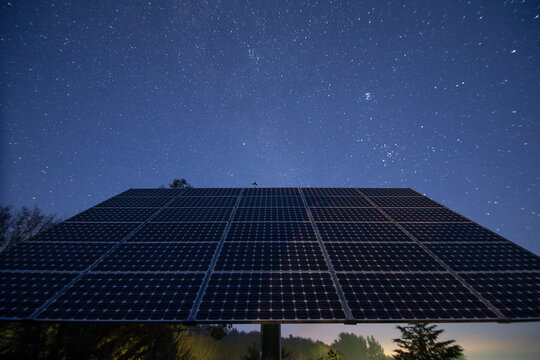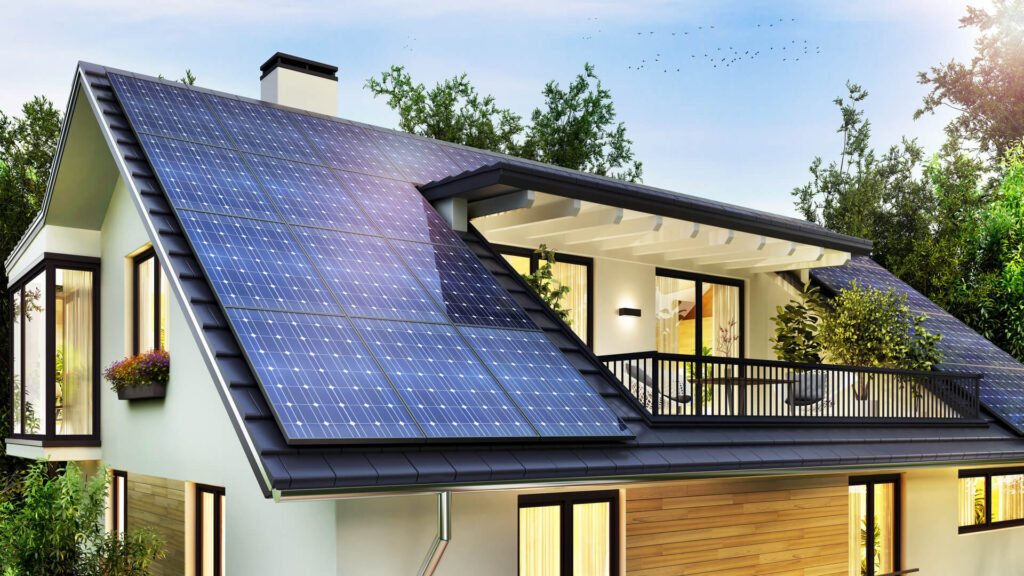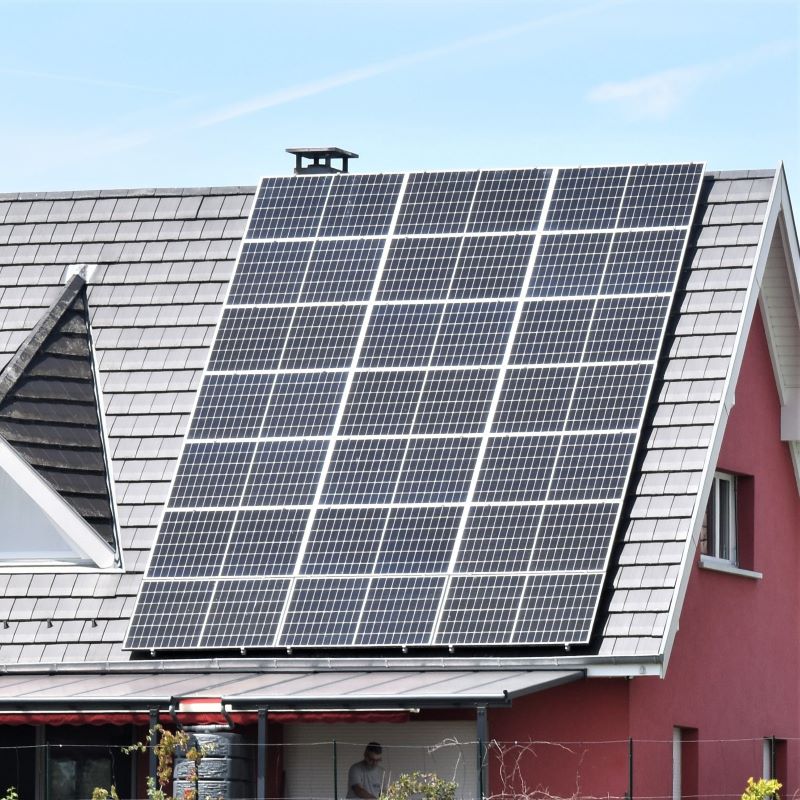Residential Solar PV
able to pay
What is Solar PV?
Solar Photovoltaics (PV) is a technology which converts renewable energy from the sun into usable electricity through the use of solar panels, that are comprised of photovoltaic cells.
Recent world events has impacted the cost to source and import energy drastically, forcing inflated energy costs. This is why Solar PV popular now more than ever. As solar energy allows families to generate their own source of renewable energy to power their homes, and save money on bills. Not to mention, Solar PV is TAX-FREE, but this may be due to change in 2027.

Who can get Solar PV?
Our Solar PV residential packages generally applies to home owners, but is not limited to. Solar PV is available to anyone with a sufficient sized, South-facing roof to fit solar panels, whether you are a home owner, landlord or tenant, we want everyone to reap the benefits of renewable energy.
How does Solar PV work?
In theory, almost anyone with suitable roof or ground space and resources can get solar PV. However, there are some practical considerations that may affect your eligibility, depending on various factors:
Property ownership:
- Homeowners: Owning your property generally gives you the most freedom to install solar panels. You’ll have control over the system and can receive any available financial incentives.
- Tenants: Some landlords may be open to solar installation, but you’ll need their permission and might not be eligible for certain financial benefits.
- Council: Properties owned by the council, require planning permission and building regulations before work commences.
- Businesses: Businesses of all sizes can benefit from solar PV, often with more generous financial incentives compared to residential installations.
Location:
- Sunlight availability: Solar panels require sufficient sunlight exposure to generate electricity effectively. So, consider your location’s average solar hours and potential shading from trees or buildings.
- Roof suitability: Your roof needs to be structurally sound and have enough space for the number of panels required to meet your energy needs. Different roof types (pitched, flat, etc.) might necessitate specific panel installation strategies.
- Local regulations: Check your local zoning and building codes to ensure they permit solar panel installations and any specific requirements they may have.
Financial aspects:
- Upfront costs: While costs have fallen, initial investment in solar panels and installation can be significant. Explore available financing options like loans, leases, or power purchase agreements (PPAs) to potentially ease the financial burden.
- Financial incentives: Many countries and regions offer rebates, tax credits, or other financial incentives to encourage solar adoption. Explore what’s available in your area to see if it makes the investment more feasible.
- Grid connection: If you intend to sell excess electricity back to the grid, ensure your local DNO (Distribution Network Operator) allows it and has capacity to handle your system. Some areas may have limitations or require specific conditions.
Other factors:
- Personal energy needs: Bee Eco analyze your electricity consumption to determine the size of solar system needed to meet your requirements. This will influence system costs and potential financial benefits.
- Long-term commitment: Solar panels typically have a lifespan of 25-30 years. Consider your long-term ownership or occupancy of the property when making the decision.
If you’re interested in solar PV, get in touch with Bee Eco now using the yellow button on the right. We will design your system and guide you through your options and advise on a system suitability for your needs.
Remember, even if you don’t fit perfectly into any category, don’t rule out solar PV entirely. Bee Eco love a challenge and we can discuss alternative renewable energy solutions such as wind energy.
Why is it essential to get Solar PV in 2024?
There are several compelling reasons why getting solar PV in 2024 could be a particularly smart choice:
Financial benefits:
- Cost reductions: Solar panel costs have fallen steadily over the years, making them more affordable than ever. Additionally, government incentives and rebates in many countries can further reduce upfront costs. In some cases, it’s even possible to finance your solar system with little to no money down.
- Energy savings: By generating your own electricity, you can significantly reduce your electricity bills. Depending on your location and system size, you could save thousands of pounds over the lifespan of your panels. With rising energy costs, this benefit is likely to become even more significant in the future.
- Increased home value: Homes with solar panels often sell for more than comparable homes without them. This is because buyers recognize the financial and environmental benefits of solar energy.
Environmental benefits:
- Reduced carbon footprint: Solar power is a clean and renewable energy source that doesn’t produce greenhouse gas emissions. By switching to solar, you can significantly reduce your carbon footprint and help combat climate change.
- Energy independence: You’ll be less reliant on the traditional electricity grid, which can be vulnerable to power outages and price fluctuations. With solar panels and battery storage, you can generate and store your own electricity, giving you greater energy security.
- Improved air quality: Solar energy doesn’t contribute to air pollution, unlike fossil fuels, which can lead to respiratory problems and other health issues.
Technological advancements:
- More efficient panels: Solar panel technology continues to improve, with new panels becoming more efficient at converting sunlight into electricity. This means you can generate more power with fewer panels, making them a more attractive option for smaller spaces.
- Battery storage options: Solar battery storage technology is also rapidly evolving, making it more affordable and practical to store excess solar energy for later use. This allows you to use solar power even when the sun isn’t shining, further increasing your energy independence.
Current conditions:
- Rising energy prices: As mentioned earlier, traditional energy costs are on the rise, making solar power an even more attractive alternative.
- Growing environmental concern: More and more people are concerned about climate change and looking for ways to reduce their environmental impact. Solar power is a great way to do both.
**Of course, the decision of whether or not to get solar PV depends on your individual circumstances and needs. However, with all the positive factors in 2024, it is definitely worth considering.
Here are some additional resources that you may find helpful:**
- Solar Energy Industries Association (SEIA): https://www.seia.org/
- National Renewable Energy Laboratory (NREL): https://www.nrel.gov/
- Energy Star: https://www.energystar.gov/
What's the process?
Enquire
Contact us to discover what you can save.
Initial Proposal
We create an initial design and price that will be accurate enough to make an informed decision.
Survey
We conduct a site survey to check roof condition and connection details.
Confirmation
We will then send a formal proposal that outlines the costs and install time.
Installation
We will book a convenient install date with you.
Handover
We will go through how the system works with you.
How much does it cost?
Our prices are standard but can vary based on the remote survey and exact measurements of what you need.
- 3KW – standard kit starts at £4350.
- Hybrid inverter starts at £499.
- 3KW battery starts at £7499.
How much can I save?
olar PV, which stands for “photovoltaic,” works by converting sunlight directly into electricity through a process called the photovoltaic effect. Here’s the breakdown:
Components:
- Solar panels: These are the main units, containing numerous solar cells made of semiconductor materials like silicon.
- Solar cells: These tiny units absorb sunlight and use the photovoltaic effect to create electricity.
- Inverter: This converts the direct current (DC) electricity generated by the cells into alternating current (AC) electricity, which is compatible with your home appliances and the grid.
- Mounting system: This securely attaches the solar panels to your roof or other suitable location.
- Optional: Battery storage: This allows you to store excess solar energy for later use, increasing independence from the grid.
The process:
- Sunlight hits the solar cell: Photons, tiny packets of energy in sunlight, are absorbed by the semiconductor material in the cell.
- Electrons excited: The absorbed photons excite electrons in the semiconductor, allowing them to move freely.
- Electric current flows: An internal electric field within the cell directs the flow of these excited electrons, creating an electric current.
- DC electricity generated: The movement of electrons through the cell produces direct current (DC) electricity.
- Inverter converts to AC: The inverter transforms the DC electricity from the cells into alternating current (AC) electricity, suitable for powering your home or business.
- Electricity used or sent to grid: You can use the generated electricity directly to power your appliances, sell it back to the grid through a feed-in tariff, or store it in a battery.
Additional factors:
- Efficiency: The efficiency of your solar panels determines how much sunlight energy they can convert into electricity. Modern panels can reach efficiencies of 20-25%.
- System size: The size of your system, measured in kilowatt-peak (kWp), depends on your energy needs and available roof space. A larger system generates more electricity but also requires more investment.
- Sun exposure: The amount of sunlight your panels receive will impact their electricity production. Consider factors like local climate, roof orientation, and potential shading.
Solar PV is a clean and renewable energy source that can help you reduce your reliance on fossil fuels, lower your electricity bills, and contribute to a sustainable future.
Why Choose Bee Eco?
We want to help you go green
Bee Eco is dedicated to assisting households in reducing both their carbon footprint and running costs by implementing eco-friendly technologies within homes. Our offerings include the installation of solar panels and battery storage, either individually or in any desired combination. Whether it’s a simple 3kW Solar PV System or a 200kW housing estate we can handle projects of any scale.
Once you’ve chosen a green technology solution from Bee Eco, our goal is to ensure you receive the best service from the initial consultation to completion. Our longstanding reputation as one of the country’s most reliable renewable energy and ECO companies has been established through years of delivering exceptional service. We refrain from aggressive sales tactics and instead focus on providing clear explanations of the costs and benefits associated with your system, allowing you to make informed decisions.

our intentions are in favour of the people and the planet

Crafting a home solar panel system involves a blend of artistry and scientific precision. Our project managers undergo extensive training in solar design, ensuring you engage with a true expert. Our approach to domestic solar systems is entirely personalized, tailored to your house and lifestyle. We prioritize quality over cost-cutting measures and refrain from pushing inappropriate options solely for profit. Here are some distinctive aspects of our approach:
- We exclusively utilize Tier 1 panels to ensure top-notch quality.
- Our selection process involves specifying the most suitable panels, inverters, and mounting systems for your home solar installation.
- We avoid overcrowding panels into every available inch of roof space, especially if it compromises aesthetic appeal.
- We steer clear of installing panels in shaded areas whenever possible.
- We recognize that it’s not just about energy generation; the visual aspect of your home is equally important.
- What sets us apart in the solar industry is our absence of salespeople. The project manager overseeing your property survey is a fully trained solar designer and a genuine expert in PV and battery technology. This means you can pose any question, and we’ll provide you with a straightforward answer.
Where do I start?
All you need to do is to call us on 0121 392 7118 and we will go through a short survey to understand your needs and collect the necessary information needed to complete your proposal.
Information we are likely to ask includes:
- Contact details
- Site address
- Annual consumption (found on energy bill)
- Unit rates (found on energy bill)
- Further information about your desired kit.
additional information
What does a Solar System comprise of?
The Solar Panels
As an independent business, we are not tied to using a particular brand of solar panels. But we only use Tier 1 panels such as Longi, Trina, Canadian Solar, JA Solar and more that are highly efficient and powerful. In order, to provide the most competitive pricing for our domestic solar packages, we commonly use 420 watt mono (black) solar panels with silver frames. If you prefer a more sleek complete mono (all black) look for your home, you can opt for a panel upgrade for only an additional £35 per panel!
The Inverters
Inverters are an essential component to your solar system. This converts the direct current (DC – raw) into an Alternating Current (AC – tame) that is safe to power your home. This can be stored either in a garage, loft or utility room. Our domestic solar packages comprise of SolaX string inverters.
OR you can opt for an upgrade with the safest, most reliable and most efficient highest technology – Enphase microinverters. Enphase Microinverters, save space within your home as they are connected with the solar panels on your roof. This option is much safer than string inverters due to the location, they convert from DC to AC (safer current) straight away, as opposed to travelling across the whole roof to get to the inverter. You can also track the performance of each panel, which is ideal for future maintenance.
Battery Storage
Mounting Kits
Mounting kits are one of the most project-specific elements to hold the solar panels firmly on your roof. We use various brands of mounting kits including, Clenergy, Renusol and Van der Valk to cater to a wide range of roof styles, materials & pitches. We can generally assess your roof from a desktop survey, but we may also pop-in to collect some up to date drone footage for a better look.
PLEASE NOTE: Slate tiled roofs are extremely volatile to work with, which may incur additional fees.
Cables and Accessories
These are relatively standard electrical components that only really vary in the amount we need per project. Our software automatically creates our list of accessories we require for each project.
What can affect the performance of my Solar PV System?
TIPS: How to save money on energy bills?
Many homeowners may look to invest in solar panels is to generate energy directly, causing your monthly electricity bills to drop.
You can save more on your electricity bills depending on when you use the most appliances. This is because any electricity which reduces your electricity consumption, rather than being fed into the national grid, will make you greater savings.
You can make reductions by using more electrical devices in the daytime when your solar panels will be generating electricity and can directly power them.
With an SEG tariff, energy suppliers have the ability to decide on the rate of pay, the length of the contract, and whether or not the tariff will be fixed or variable. Fixed SEG tariffs pay a set rate of a kilowatt-hour (kWh) of electricity exported over the length of a contract.
